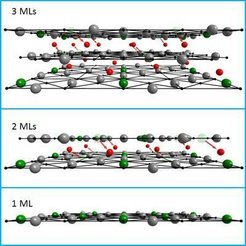Dynamic atomic reconstruction: how Fe3O4 thin films evade polar catastrophe for epitaxy
Physical properties of surfaces and interfaces of solids could markedly differ from those in the bulk, especially in cases when the surface or interface involves non-neutral crystal planes. For insulators, the stacking of such polar planes causes the electrostatic potential to diverge, in a similar manner like stacking a series of capacitors. This so-called ‘polar catastrophe’ destabilizes the system in a dramatic manner and enforces the surface or interface to behave very differently than the bulk. A representative example is the interface of SrTiO3/LaAlO3 as well as that of SrTiO3/RETiO3 (RE = rare earth). The formation of a two-dimensional electron gas and the occurrence of even superconductivity in this interface between two insulating materials has generated frantic efforts worldwide. However, the growth process of these interfaces and polar interfaces in general remains a mystery. How do the atoms rearrange themselves during the deposition or growth such that a well ordered and smooth interface is formed, despite the destabilizing forces due to the catastrophic electrostatic potential?
Recently, MPI CPfS scientists, in collaboration with University of Cologne, Hiroshima University, ESRF, and NSRRC, make a paradigm shift in understanding how polar interfaces can grow through investigating the polar interface between Fe3O4 and the MgO (001) substrate, one of the most used interfaces in the research field of spintronics. We use molecular beam epitaxy which allows for a layer-by-layer growth of Fe3O4 films under ultra clean conditions. Utilizing spectroscopy with synchrotron radiation, we discover that the certain types of Fe ions are missing in the first Fe3O4 monolayer. Together with the data on thicker films, we are able to develop an unexpected but elegant growth principle in which during deposition not only the surface but also the sub-surface Fe atoms are constantly on the move to solve the divergent electrostatic potential problem, thereby ensuring epitaxy and stoichiometry at the same time. Having identified this ‘dynamic atomic reconstruction’ growth principle, we can conclude that we really have to think differently and openly about how polar interfaces can grow. Apparently, ‘nature’ offers us a much wider range of opportunities to prepare unstable polar interfaces. This realization can therefore be utilized in the research field of thin film devices and nano science to create novel functionalities.
CFC, LHT / CPfS

Model for the growth process of polar Fe3O4 (001) thin films. The A-site Fe3+ ions are missing in the first Fe3O4 layer and the growth process involves movements of not only the surface but also the subsurface Fe ions, securing epitaxy and stoichiometry at the same time. Gray balls: B-site Fe2+/Fe3+. Green balls: extra B-site Fe3+. Red balls: A-site Fe3+. Black balls: oxygens.
